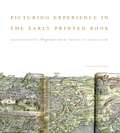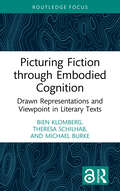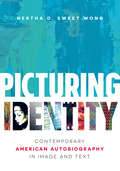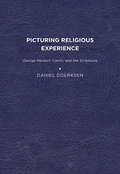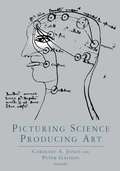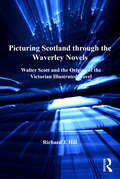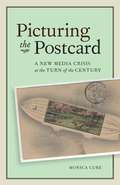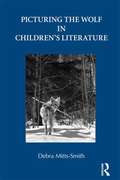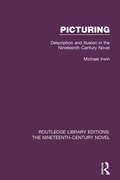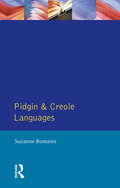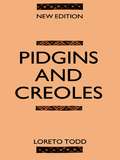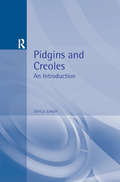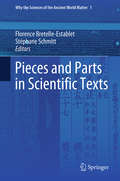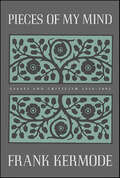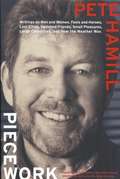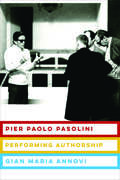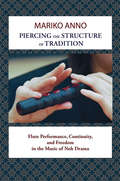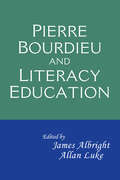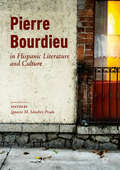- Table View
- List View
Picturing Canada
by Judith Saltman Gail EdwardsThe study of children's illustrated books is located within the broad histories of print culture, publishing, the book trade, and concepts of childhood. An interdisciplinary history, Picturing Canada provides a critical understanding of the changing geographical, historical, and cultural aspects of Canadian identity, as seen through the lens of children's publishing over two centuries.Gail Edwards and Judith Saltman illuminate the connection between children's publishing and Canadian nationalism, analyse the gendered history of children's librarianship, identify changes and continuities in narrative themes and artistic styles, and explore recent changes in the creation and consumption of children's illustrated books. Over 130 interviews with Canadian authors, illustrators, editors, librarians, booksellers, critics, and other contributors to Canadian children's book publishing, document the experiences of those who worked in the industry.An important and wholly original work, Picturing Canada is fundamental to our understanding of publishing history and the history of childhood itself in Canada.
Picturing Experience in the Early Printed Book: Breydenbach’s Peregrinatio from Venice to Jerusalem
by Elizabeth RossBernhard von Breydenbach’s Peregrinatio in terram sanctam (Journey to the Holy Land), first published in 1486, is one of the seminal books of early printing and is especially renowned for the originality of its woodcuts. In Picturing Experience in the Early Printed Book, Elizabeth Ross considers the Peregrinatio from a variety of perspectives to explain its value for the cultural history of the period. Breydenbach, a high-ranking cleric in Mainz, recruited the painter Erhard Reuwich of Utrecht for a religious and artistic adventure in a political hot spot—a pilgrimage to research the peoples, places, plants, and animals of the Levant. The book they published after their return ambitiously engaged with the potential of the new print medium to give an account of their experience.The Peregrinatio also aspired to rouse readers to a new crusade against Islam by depicting a contest in the Mediterranean between the Christian bastion of the city of Venice and the region’s Muslim empires. This crusading rhetoric fit neatly with the state of the printing industry in Mainz, which largely subsisted as a tool for bishops’ consolidation of authority, including selling the pope’s plans to combat the Ottoman Empire.Taking an artist on such an enterprise was unprecedented. Reuwich set a new benchmark for technical achievement with his woodcuts, notably a panorama of Venice that folds out to 1.62 meters in length and a foldout map that stretches from Damascus to Sudan around the first topographically accurate view of Jerusalem. The conception and execution of the Peregrinatio show how and why early printed books constructed new means of visual representation from existing ones—and how the form of a printed book emerged out of the interaction of eyewitness experience and medieval scholarship, real travel and spiritual pilgrimage, curiosity and fixed belief, texts and images.
Picturing Experience in the Early Printed Book: Breydenbach’s Peregrinatio from Venice to Jerusalem
by Elizabeth RossBernhard von Breydenbach’s Peregrinatio in terram sanctam (Journey to the Holy Land), first published in 1486, is one of the seminal books of early printing and is especially renowned for the originality of its woodcuts. In Picturing Experience in the Early Printed Book, Elizabeth Ross considers the Peregrinatio from a variety of perspectives to explain its value for the cultural history of the period. Breydenbach, a high-ranking cleric in Mainz, recruited the painter Erhard Reuwich of Utrecht for a religious and artistic adventure in a political hot spot—a pilgrimage to research the peoples, places, plants, and animals of the Levant. The book they published after their return ambitiously engaged with the potential of the new print medium to give an account of their experience.The Peregrinatio also aspired to rouse readers to a new crusade against Islam by depicting a contest in the Mediterranean between the Christian bastion of the city of Venice and the region’s Muslim empires. This crusading rhetoric fit neatly with the state of the printing industry in Mainz, which largely subsisted as a tool for bishops’ consolidation of authority, including selling the pope’s plans to combat the Ottoman Empire.Taking an artist on such an enterprise was unprecedented. Reuwich set a new benchmark for technical achievement with his woodcuts, notably a panorama of Venice that folds out to 1.62 meters in length and a foldout map that stretches from Damascus to Sudan around the first topographically accurate view of Jerusalem. The conception and execution of the Peregrinatio show how and why early printed books constructed new means of visual representation from existing ones—and how the form of a printed book emerged out of the interaction of eyewitness experience and medieval scholarship, real travel and spiritual pilgrimage, curiosity and fixed belief, texts and images.
Picturing Fiction through Embodied Cognition: Drawn Representations and Viewpoint in Literary Texts (Routledge Focus on Linguistics)
by Michael Burke Bien Klomberg Theresa SchilhabThis concise volume addresses the question of whether or not language, and its structure in literary discourses, determines individuals’ mental ‘vision,’ employing an innovative cross-disciplinary approach using readers’ drawings of their mental imagery during reading. The book engages in critical dialogue with the perceived wisdom in stylistics rooted in Roger Fowler’s seminal work on deixis and point of view to test whether or not this theory can fully account for what readers see in their mind's eye and how they see it. The work draws on findings from a study of English and Dutch across a range of literary texts, in which participants read literary text fragments and were then asked to immediately draw representations of what they had seen envisioned. Building on the work of Fowler and more recent theoretical and empirical language-based studies in the area, Klomberg, Schilhab and Burke argue that models from embodied cognitive science can help account for anomalies in evidence from readers’ drawings, indicating new ways forward for interdisciplinary understandings of individual meaning construction in literary textual interfaces. This book will be of interest to students and scholars in stylistics, cognitive psychology, rhetoric, and philosophy, particularly those working in embodied cognition.
Picturing Fiction through Embodied Cognition: Drawn Representations and Viewpoint in Literary Texts (Routledge Focus on Linguistics)
by Michael Burke Bien Klomberg Theresa SchilhabThis concise volume addresses the question of whether or not language, and its structure in literary discourses, determines individuals’ mental "vision," employing an innovative cross-disciplinary approach using readers’ drawings of their mental imagery during reading. The book engages in critical dialogue with the perceived wisdom in stylistics rooted in Roger Fowler’s seminal work on deixis and point of view to test whether or not this theory can fully account for what readers see in their mind's eye and how they see it. The work draws on findings from a study of English and Dutch across a range of literary texts, in which participants read literary text fragments and were then asked to immediately draw representations of what they had seen envisioned. Building on the work of Fowler and more recent theoretical and empirical language-based studies in the area, Klomberg, Schilhab, and Burke argue that models from embodied cognitive science can help account for anomalies in evidence from readers’ drawings, indicating new ways forward for interdisciplinary understandings of individual meaning construction in literary textual interfaces.This book will be of interest to students and scholars in stylistics, cognitive psychology, rhetoric, and philosophy, particularly those working in the field of embodied cognition.The Open Access version of this book, available at http://www.taylorfrancis.com, has been made available under a Creative Commons Attribution-Non-Commercial (CC-BY-NC-) 4.0 license.
Picturing Identity: Contemporary American Autobiography in Image and Text
by Hertha D. WongIn this book, Hertha D. Sweet Wong examines the intersection of writing and visual art in the autobiographical work of twentieth- and twenty-first-century American writers and artists who employ a mix of written and visual forms of self-narration. Combining approaches from autobiography studies and visual studies, Wong argues that, in grappling with the breakdown of stable definitions of identity and unmediated representation, these writers-artists experiment with hybrid autobiography in image and text to break free of inherited visual-verbal regimes and revise painful histories. These works provide an interart focus for examining the possibilities of self-representation and self-narration, the boundaries of life writing, and the relationship between image and text. Wong considers eight writers-artists, including comic-book author Art Spiegelman; Faith Ringgold, known for her story quilts; and celebrated Indigenous writer Leslie Marmon Silko. Wong shows how her subjects formulate webs of intersubjectivity shaped by historical trauma, geography, race, and gender as they envision new possibilities of selfhood and fresh modes of self-narration in word and image.
Picturing Religious Experience: George Herbert, Calvin, and the Scriptures
by Daniel DoerksenLittle has been said about the relationship of Herbert’s writings to those of John Calvin, yet the latter were abundant and influential in Herbert’s Church of England. Accordingly Picturing Religious Experience studies Herbert’s poetry in relation to those writings, particularly regarding “spiritual conflicts,” which the poet himself said would be found depicted in his book of poems. Much more than is generally realized, Calvin wrote about the experience of living the Christian life—which is also Herbert’s subject in many of his poems. Altogether, this study maintains that Herbert owes to his religious orientation not just themes or details, but an impulse to observe and depict the inner life, and scriptural patterns which significantly contribute to the substance and literary excellence of The Temple. Published by University of Delaware Press. Distributed worldwide by Rutgers University Press.
Picturing Science, Producing Art
by Peter Galison Caroline A. JonesFirst Published in 1998. Routledge is an imprint of Taylor & Francis, an informa company.
Picturing Scotland through the Waverley Novels: Walter Scott and the Origins of the Victorian Illustrated Novel
by Richard J. HillInnovative and accessibly written, Picturing Scotland examines the genesis and production of the first author-approved illustrations for Sir Walter' Scott's Waverley novels in Scotland. Consulting numerous neglected primary sources, Richard J. Hill demonstrates that Scott, usually seen as disinterested in the mechanics of publishing, actually was at the forefront of one of the most innovative publishing and printing trends, the illustrated novel. Hill examines the historical precedents, influences, and innovations behind the creation of the illustrated editions, tracking Scott's personal interaction with the mechanics of the printing and illustration process, as well as Scott's opinions on visual representations of literary scenes. Of particular interest is Scott's relationships with William Allan and Alexander Nasmyth, two important early nineteenth-century Scottish artists. As the first illustrators of the Waverley novels, their work provided a template for one of the more lucrative publishing phenomena. Informed by meticulous close readings of Scott's novels and augmented by a bibliographic catalogue of illustrations, Picturing Scotland is an important contribution to Scott studies, the development of the illustrated novel, and publishing history.
Picturing the Page: Illustrated Children’s Literature and Reading under Lenin and Stalin
by Megan SwiftBased on sources from rare book libraries in Russia and around the world, Picturing the Page offers a vivid exploration of illustrated children’s literature and reading under Lenin and Stalin – a period when mass publishing for children and universal public education became available for the first time in Russia. By analysing the illustrations in fairy tales, classic "adult" literature reformatted for children, and war-time picture books, Megan Swift elucidates the vital and multifaceted function of illustrated children’s literature in repurposing the past. Picturing the Page demonstrates that while the texts of the past remained fixed, illustrations could slip between the pages to mediate and annotate that past, as well as connect with anti-religious, patriotic, and other campaigns that were central to Soviet children’s culture after the 1917 Revolution.
Picturing the Postcard: A New Media Crisis at the Turn of the Century
by Monica CureThe first full-length study of a once revolutionary visual and linguistic medium Literature has &“died&” many times—this book tells the story of its death by postcard. Picturing the Postcard looks to this unlikely source to shed light on our collective, modern-day obsession with new media. The postcard, almost unimaginably now, produced at the end of the nineteenth century the same anxieties and hopes that many people think are unique to twenty-first-century social media such as Facebook or Twitter. It promised a newly connected social world accessible to all and threatened the breakdown of authentic social relations and even of language. Arguing that &“new media&” is as much a discursive object as a material one, and that it is always in dialogue with the media that came before it, Monica Cure reconstructs the postcard&’s history through journals, legal documents, and sources from popular culture, analyzing the postcard&’s representation in fiction by well-known writers such as E. M. Forster and Edith Wharton and by more obscure writers like Anne Sedgwick and Herbert Flowerdew. Writers deployed uproar over the new medium of the postcard by Anglo-American cultural critics to mirror anxieties about the changing nature of the literary marketplace, which included the new role of women in public life, the appeal of celebrity and the loss of privacy, an increasing dependence on new technologies, and the rise of mass media. Literature kept open the postcard&’s possibilities and in the process reimagined what literature could be.
Picturing the Wolf in Children's Literature (Children's Literature and Culture #69)
by Debra Mitts-SmithFrom the villainous beast of “Little Red Riding Hood” and “The Three Little Pigs,” to the nurturing wolves of Romulus and Remus and Rudyard Kipling’s The Jungle Book, the wolf has long been a part of the landscape of children’s literature. Meanwhile, since the 1960s and the popularization of scientific research on these animals, children’s books have begun to feature more nuanced views. In Picturing the Wolf in Children’s Literature, Mitts-Smith analyzes visual images of the wolf in children’s books published in Western Europe and North America from 1500 to the present. In particular, she considers how wolves are depicted in and across particular works, the values and attitudes that inform these depictions, and how the concept of the wolf has changed over time. What she discovers is that illustrations and photos in works for children impart social, cultural, and scientific information not only about wolves, but also about humans and human behavior. First encountered in childhood, picture books act as a training ground where the young learn both how to decode the “symbolic” wolf across various contexts and how to make sense of “real” wolves. Mitts-Smith studies sources including myths, legends, fables, folk and fairy tales, fractured tales, fictional stories, and nonfiction, highlighting those instances in which images play a major role, including illustrated anthologies, chapbooks, picture books, and informational books. This book will be of interest to children’s literature scholars, as well as those interested in the figure of the wolf and how it has been informed over time.
Picturing: Description and Illusion in the Nineteenth Century Novel (Routledge Library Editions: The Nineteenth-Century Novel #21)
by Michael IrwinFirst published in 1979. Most of the great nineteenth century novelists strove to render in words the people and places that they invented and most readers of fiction picture in their imagination these characters and scenes. This book investigates both types of ‘picturing’, exploring the principles and problems concerned, and sheds light on the workings of fiction — reassessing a number of famous novels in the process. By so doing, this work relates the academic study of the novel to the writing and reading of fiction, and the teaching of creative writing. This book will appeal to students of literature.
Pida la palabra. Los secretos de un gran orador para seducir a cualquier audiencia.: Los secretos de un gran orador para seducir a cualquier audiencia
by García AlanPierda el miedo al escenario y descubra cómo conquistar y seducir al auditorio. Durante muchos años se creyó que memorizar un discurso era fundamental para exponer las ideas de manera incuestionable. Gran error. El orador debe confiar en su memoria, sí, pero más en la capacidad de ser uno con el público, debe permitir que las ideas fluyan, que el cuerpo exprese la exaltación y los gestos sean un vocablo potente y digno. Si el expositor es un hombre audaz e instruido, no es indispensable encomendarse a la memoria, mucho menos leer un documento, para fundamentar sus convicciones.En este libro esencial para aprender a dirigirse al público, dominar el escenario y someter nuestros miedos, el destacado político y ex presidente de Perú, el doctor Alan García #además extraordinario orador- ofrece los secretos para hacer de la palabra, acción compartida. En estas páginas habla de la importancia de una dicción clara yfuerte, del manejo del cuerpo, de la necesidad de mantener una presencia indeclinable y del dominio de los temas.Revela que es indispensable hablar fuerte y con decisión, preparar con seriedad la exposición y acudir al ejemplo de discursos inolvidables. Por esta razón y con el fin de hacer más contundente este libro, analiza y celebra textos inmortales de William Shakespeare, Martin Luther King, Jesucristo, Franklin D. Roosevelt, Haya de la Torre, Kennedy, entre otros grandes personajes, sin soslayar el ritmo, la música y la potencia sonora de versos de Santos Chocano, Neruda o García Lorca.Pida la palabra es el libro que transformará la forma en que se elabora un discurso y la manera infalible de hacer que los auditorios se entreguen, conmovidos, a la emotividad y convicción del orador.
Pidgin and Creole Languages: Longman Linguistics Library (Longman Linguistics Library)
by Suzanne RomaineThis book defines and describes the linguistic features of these languages and considers the dynamic developments that bring them into being and lead to changes in their structure.
Pidgins and Creoles
by Loreto Todd Professor Loreto ToddThe focus of this study is upon those pidgins and creoles which are English based and which have arisen since the fifteenth century. The book examines the widespread nature of the pidgin/creole phenomenon and evaluates the current definitions of the terms and the theories which have been advanced to account for their existence. The author considers the potential of pidgins and creoles as literary media and as vehicles for education. She looks at the sociological and psychological implications of using pidgins and creoles in the classroom and examines the position of American `Black English' and `London Jamaican' in the pidgin/creole continuum.
Pidgins and Creoles: An Introduction
by Ishtla SinghPidgins and creoles have always attracted a great deal of interest - academic and otherwise - but in recent decades they have become increasingly important as a field of linguistic inquiry. Placing pidgins and creoles in the wider setting of linguistic theory, this book bridges the gap between introductory material and primary material, revising students' knowledge of the field as well as acquainting them with key areas of debate in pidgin and creole studies. The author provides a carefully balanced introduction to theoretical aspects of creolistics as well as an even-handed discussion of influences on pidgins and creoles which is well illustrated with rare examples of longer texts.
Pieces and Parts in Scientific Texts (Why the Sciences of the Ancient World Matter #1)
by Florence Bretelle-Establet Stéphane SchmittThis book starts from a first general observation: there are very diverse ways to frame and convey scientific knowledge in texts. It then analyzes texts on mathematics, astronomy, medicine and life sciences, produced in various parts of the globe and in different time periods, and examines the reasons behind the segmentation of texts and the consequences of such textual divisions. How can historians and philosophers of science approach this diversity, and what is at stake in dealing with it? The book addresses these questions, adopting a specific approach to do so. In order to shed light on the diversity of organizational patterns and rhetorical strategies in scientific texts, and to question the rationale behind the choices made to present such texts in one particular way, it focuses on the issue of text segmentation, offering answers to questions such as: What was the meaning of segmenting texts into paragraphs, chapters, sections and clusters? Was segmentation used to delimit self-contained units, or to mark breaks in the physical appearance of a text in order to aid reading and memorizing, or to cope with the constraints of the material supports? How, in these different settings and in different texts, were pieces and parts made visible?
Pieces of My Mind: Essays and Criticism 1958–2002
by Frank KermodeSir Frank Kermode has been writing peerless literary criticism for more than a half-century. Pieces of My Mind includes his own choice of his major essays since 1958, beginning with his extraordinary study of "Poet and Dancer Before Diaghilev" and ending with a marvelous consideration of Shakespeare's Othello and Verdi-Boito's Otello. Important essays on Hawthorne, on Wallace Stevens, on problems in literary theory and analysis, on Auden, on "Secrets and Narrative Sequence," and three previously unpublished essays (including one on "Memory" and one on "Forgetting") fill out this rich and rewarding volume. Pieces of My Mind also contains recent considerations of the work of major modern writers--Don DeLillo, Raymond Carver, Tom Paulin, and others. Of Kermode's last book, Shakespeare's Language, Richard Howard wrote that it was "a triumph of inauguration and the crowning action of his splendid career of criticism. It is, and will doubtless remain, the first book one should read about Shakespeare's plays, and with those plays." Pieces of My Mind has equal authority and power, and it will be equally praised.
Piecework: Writings on Men & Women, Fools and Heroes, Lost Cities, Vanished Calamities and How the Weather Was
by Pete HamillVeteran journalist Pete Hamill has never covered just politics. Or just sports. Or just the entertainment business, the mob, foreign affairs, social issues, the art world, or New York City. He has in fact written about all these subjects, and many more, in his years as a contributor to such national magazines as Esquire, Vanity Fair, and New York, and as a columnist at the New York Post, the New York Daily News, the Village Voice, and other newspapers. Seasoned by more than thirty years as a New York newspaperman, Hamill writes on an extraordinarily wide variety of topics in powerful language that is personal, tough-minded, clearheaded, always provocative. Piecework is a rich and varied collection of Hamill's best writing since 1970, on such diverse subjects as what television and crack have in common, why winning isn't everything, stickball, Nicaragua, Donald Trump, why American immigration policy toward Mexico is all wrong, Brooklyn's Seventh Avenue, and Frank Sinatra, not to mention Octavio Paz, what it's like to realize you're middle-aged, Northern Ireland, New York City then and now, how Mike Tyson spent his time in prison, and much more. This collection proves him once again to be among the last of a dying breed: the old-school generalist, who writes about anything and everything, guided only by passionate and boundless curiosity. Piecework is Hamill at his very best.
Pier Paolo Pasolini: In Living Memory
by Ben Lawton and Maura BergonzoniA collection of essays discussing the famed Italian film director, writer, and intellectual.More than thirty years after the tragic death of Pier Paolo Pasolini, this volume is intended to acknowledge the significance of his living memory. His artistic and cultural production continues to be a fundamental reference point in any discourse on the state of the arts, and on contemporary political events, in Italy and abroad. This collection of essays intends to continue the recognition of Pasolini’s teachings and of his role as engaged intellectual, not only as acute observer of the society in which he lived, but also as semiologist, writer, and filmmaker, always heretical in all his endeavors. Many directors, reporters, and contemporary writers see in the “inconvenient intellectual” personified by Pasolini in his writings, in his films, and in his interviews, an emblematic figure with whom to institute and maintain a constant dialog, both because of the controversial topics he addressed, which are still relevant today, and because of the ways in which he confronted the power structures. His analytical ability made it impossible for him to believe in the myth of progress; instead, he embraced an ideal that pushed him always to struggle on the firing line of controversy.
Pier Paolo Pasolini: Performing Authorship
by Gian Maria AnnoviBefore his mysterious murder in 1975, Pier Paolo Pasolini had become famous—and infamous—not only for his groundbreaking films and literary works but also for his homosexuality and criticism of capitalism, colonialism, and Western materialism. In Pier Paolo Pasolini: Performing Authorship, Gian Maria Annovi revisits Pasolini's oeuvre to examine the author's performance as a way of assuming an antagonistic stance toward forms of artistic, social, and cultural oppression. Annovi connects Pasolini's notion of authorship to contemporary radical artistic practices and today's multimedia authorship.Annovi considers the entire range of Pasolini's work, including his poetry, narrative and documentary film, dramatic writings, and painting, as well as his often scandalous essays on politics, art, literature, and theory. He interprets Pasolini's multimedia authorial performance as a masochistic act to elicit rejection, generate hostility, and highlight the contradictions that structure a repressive society. Annovi shows how questions of authorial self-representation and self-projection relate to the artist's effort to undermine the assumptions of his audience and criticize the conformist practices that the culture industry and mass society impose on the author. Pasolini reveals the critical potential of his spectacular celebrity by using the author's corporeal or vocal presence to address issues of sexuality and identity, and through his strategic self-fashioning in films, paintings, and photographic portraits he destabilizes the audience's assumptions about the author.
Piercing the Structure of Tradition: Flute Performance, Continuity, and Freedom in the Music of Noh Drama
by Mariko AnnoWhat does freedom sound like in the context of traditional Japanese theater? Where is the space for innovation, and where can this kind of innovation be located in the rigid instrumentation of the Noh drama? In Piercing the Structure of Tradition, Mariko Anno investigates flute performance as a space to explore the relationship between tradition and innovation. This first English-language monograph traces the characteristics of the Noh flute (nohkan), its music, and transmission methods and considers the instrument's potential for development in the modern world. Anno examines the musical structure and nohkan melodic patterns of five traditional Noh plays and assesses the degree to which Issō School nohkan players maintain to this day the continuity of their musical traditions in three contemporary Noh plays influenced by Yeats. Her ethnographic approach draws on interviews with performers and case studies, as well as her personal reflection as a nohkan performer and disciple under the tutelage of Noh masters. She argues that traditions of musical style and usage remain influential in shaping contemporary Noh composition and performance practice, and the existing freedom within fixed patterns can be understood through a firm foundation in Noh tradition.
Pierre Bourdieu and Literacy Education
by James Albright Allan LukeIn this volume scholars from around the world focus on how a Bourdieusian stance can enable a powerful socicultural and cultural analysis of literacy education theory and practice and serve as an effective tool in analyzing relations of hierarchy and domination. Although there has been a growing body of Bourdieusian-inspired research in various sectors of education, this book is the first to present both theoretical and practical articulation of his ideas in the field of literacy education. It brings together three major clusters of work: Rethinking of the doxa of the social fields of language and literacy education Explorations of alternative objectifications of educational fields forming around cultural and linguistic minorities, new media and technologies Studies on the formation of the literate habitus in homes and classrooms, curriculum and schooling, and addresses theoretical, policy and practical directions Pierre Bourdieu and Literacy Education is intended for researchers, practitioners, and graduate students in literacy education, sociology of education, and curriculum theory, and as a text for advanced courses in these areas.
Pierre Bourdieu in Hispanic Literature and Culture
by Ignacio M. Sánchez PradoPierre Bourdieu in Hispanic Literature and Culture is a collective reflection on the value of French sociologist Pierre Bourdieu’s work for the study of Spanish and Latin American literature and culture. The authors deploy Bourdieu’s concepts in the study of Modernismo, avant-garde Mexico, contemporary Puerto Rican literature, Hispanism, Latin American cultural production, and more. Each essay is also a contribution to the study of the politics and economics of culture in Spain and Latin America. The book, as a whole, is in dialogue with recent methodological and theoretical interventions in cultural sociology and Latin American and Iberian studies.

